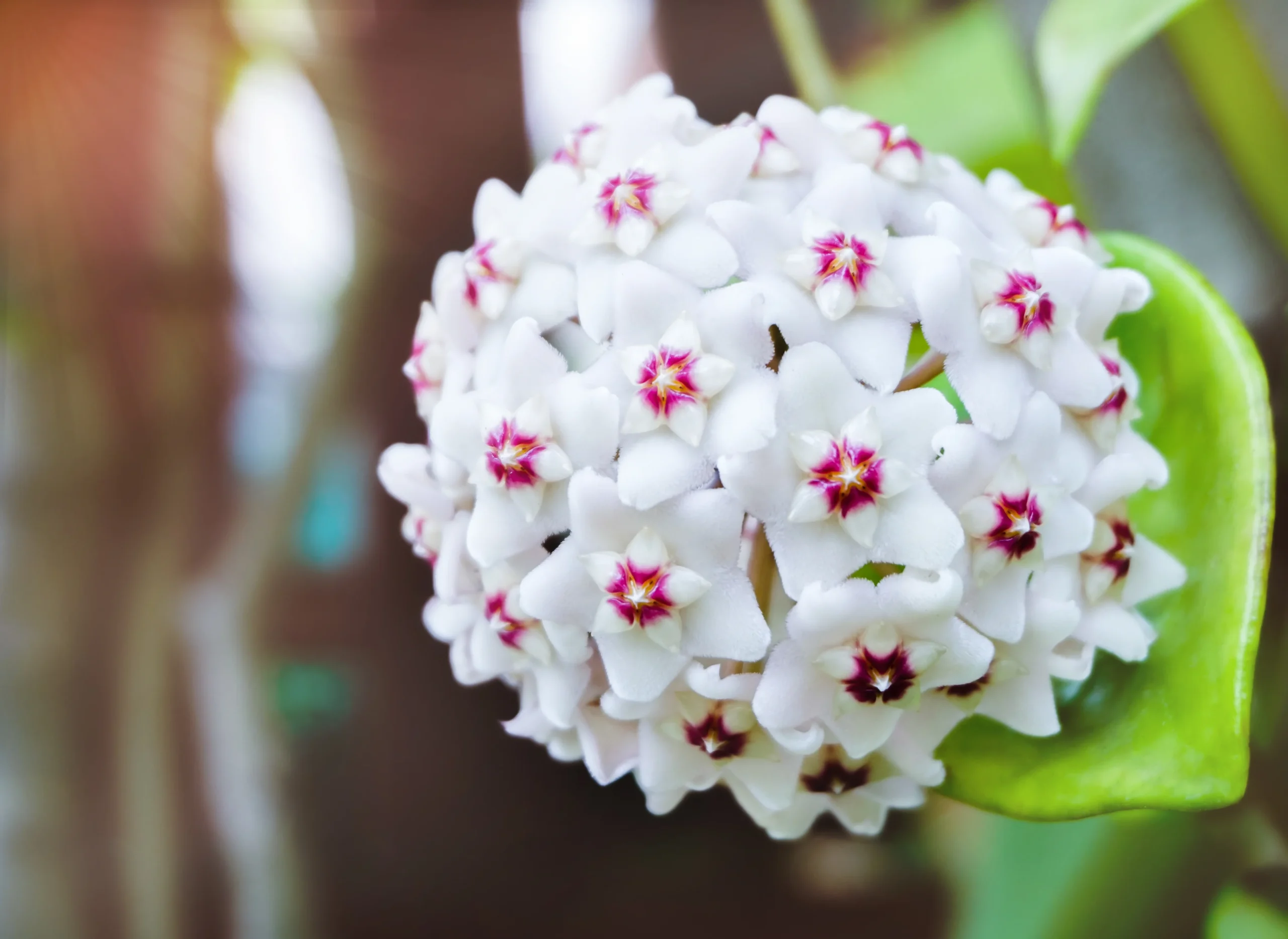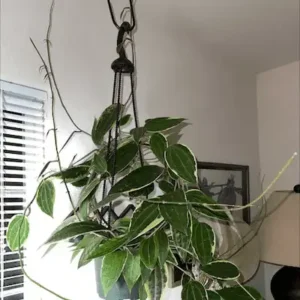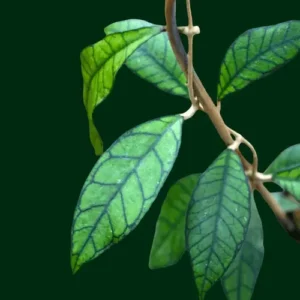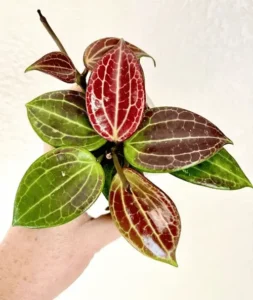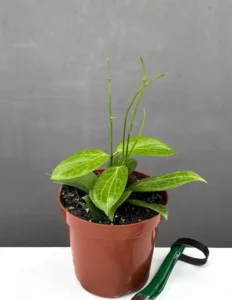Hoya plant blooming
The blooming of a Hoya plant is a captivating event that showcases nature’s beauty and complexity. Known for their waxy, star-shaped flowers that often emit a delightful fragrance, Hoyas are beloved by plant enthusiasts for their unique leaf shape and blooms. When a Hoya plant is blooming, it’s truly a sight to behold. Hoyas can last for several weeks.
Hoya Plant Blooming Facts
Here’s what to expect and some interesting facts about the Hoya plant blooming.
Flower Appearance:
– Star-Shaped Flowers: Each Hoya flower is star-shaped, featuring five symmetrical petals that come together to form a small star. Within this larger star is a smaller, raised central star, creating a layered, three-dimensional effect.
– Umbel Clusters: The flowers grow in clusters called umbels, which can range from a few flowers to several dozen, depending on the species. These clusters hang down from the plant, creating a stunning display.
– Waxy and Porcelain-Like: Hoya flowers have a distinct waxy, almost porcelain-like texture. This gives them a shiny, glossy appearance, making them look as if they were sculpted from wax.
– Fleshy Petals: The petals are thick and fleshy, which contributes to their waxy look and makes them long-lasting.
– variety of Colors: The color of Hoya flowers varies by species and can range from white to pink, red, yellow, or even purple. The color of Hoya flowers varies widely among species and cultivars. Common colors include white, pink, red, yellow, and even purple. Some flowers may have a combination of colors, with the central star being a different color than the outer petals.
– Color Gradation: Some Hoya flowers exhibit a gradation of color, with deeper hues at the tips of the petals and lighter shades towards the center.
– Scent: Many Hoya species produce fragrant flowers, with scents ranging from sweet and floral to spicy or citrusy, often more noticeable in the evening.
Blooming Period:
– Timing: Hoyas generally bloom during the warmer months, typically in spring or summer. However, with the right conditions, some species can bloom multiple times a year.
– Duration: Once in bloom, the flowers can last anywhere from a few days to several weeks, depending on the species and care.
Flowering Stems (Peduncles):
– Reblooming: Hoyas produce flowers on special stems called peduncles. It’s essential not to cut these off after the flowers fade, as Hoyas can rebloom from the same peduncle in the future.
– Growth: Over time, these peduncles can elongate and produce more flower clusters each blooming season.
Encouraging Blooms:
– Light and Care: As mentioned before, ensuring your Hoya gets bright, indirect light and proper care is key to encouraging blooms.
Common notable Species and Their Blooms:
– Hoya carnosa: One of the most popular species, with pale pink or white flowers that have a sweet fragrance.
– Hoya kerrii: Known for its heart-shaped leaves, it produces creamy white to yellow flowers.
– Hoya pubicalyx: This species has dark green leaves with silvery spots and produces clusters of dark pink to red flowers.
Longevity:
– Long-Lasting Blooms: Hoya flowers can last several days to weeks, making them a long-lasting and rewarding bloom for plant enthusiasts.
Fragrance:
Many Hoya species produce a sweet, often intense fragrance that is most noticeable in the evening. The scent can range from floral to spicy or citrusy, depending on the species. The fragrance of Hoya flowers is one of their most charming features, adding an aromatic dimension to hoya plant blooming. Whether sweet and floral, citrusy, or spicy, the scent of a blooming Hoya can fill a room with a delightful and soothing aroma, making these plants a joy to grow indoors
Fragrance appreciates scented plants
Many Hoya species produce a strong and noticeable fragrance, which often becomes more pronounced during the evening and nighttime. This makes them particularly enjoyable for plant enthusiasts who appreciate scented plants.
Fragrance profiles
The most common scent associated with Hoya flowers is a sweet, floral aroma. This fragrance can be reminiscent of gardenias or jasmine, creating a pleasant and soothing atmosphere. Some Hoya species have a citrusy fragrance, with hints of lemon or orange, adding a fresh and invigorating scent to the environment. A few Hoya varieties have a more complex fragrance, with spicy or musky undertones that add depth to the scent profile. This can make the scent richer and more exotic.
Fragrance timing
The fragrance of Hoya flowers is often stronger in the evening or at night, which is believed to attract nocturnal pollinators in their natural habitat. This makes the plant especially enjoyable during the evening hours.
– Species-Specific Fragrances:
Hoya carnosa: Known for its sweet, vanilla-like scent that intensifies at night.
Hoya australis: Produces a sweet, honey-like fragrance that is particularly strong in the evening.
Hoya pubicalyx: Has a spicy, sweet scent with a hint of musk, making it a bit different from the typical floral Hoya fragrance.
– Fragrance Variability:
Age and Conditions: The intensity and character of the fragrance can vary depending on the age of the flowers, the time of day, and the growing conditions. Healthy plants in optimal conditions are more likely to produce stronger and more pleasant fragrances.
Aftercare:
– Post-Bloom Care: Once your Hoya has bloomed, continue regular care. Reduce watering slightly in the winter, and resume fertilizing in the spring to prepare the plant for the next blooming cycle.
Hoya blooms are a special reward for the care you give your plant, and with the right conditions, you can enjoy these beautiful and fragrant flowers year after year.
Best ways to get the Hoya plant to bloom
Getting a Hoya plant to bloom can be a rewarding process, but it requires patience and the right conditions. There are 11 best ways to get the Hoya plant to bloom.
Provide Bright, Indirect Light:
– Hoyas need plenty of light to bloom, but they don’t like direct sunlight, which can scorch their leaves. A bright, indirect light source, like a window with filtered light, is ideal.
– If natural light is insufficient, consider using a grow light.
Use the Right Potting Mix:
– Hoyas prefer a well-draining potting mix. You can use a mix designed for orchids or make your own by combining equal parts of cactus soil, perlite, and orchid bark.
Maintain the Right Temperature:
– Hoyas thrive in temperatures between 60°F and 85°F (16°C – 29°C). They prefer a slight drop in temperature at night, which can help trigger blooming.
Humidity:
– Hoyas prefer high humidity, around 60-80%. If you live in a dry area, you might need to increase humidity around your plant using a humidifier, a pebble tray with water, or regular misting.
Watering:
– Water your Hoya when the top inch of the soil feels dry. They don’t like to be waterlogged, so make sure the pot has good drainage.
– Reduce watering in the winter, as they need a rest period.
Fertilizing:
– During the growing season (spring and summer), feed your Hoya with a balanced, water-soluble fertilizer every 4-6 weeks. A fertilizer higher in phosphorus can help encourage blooming.
Pruning and reporting
Pruning
– Avoid pruning the peduncles (the small stems where flowers emerge), as Hoyas often rebloom from the same spots.
– Pruning can encourage new growth, which may lead to more blooms, but be cautious about over-pruning.
Reportting
– While reporting, give your plant a chunky mix. By doing this you will always retain your hoya.
– Just disturb your hoya as little as possible. Moreover, don’t bash the old dirt off, just drop it in the new pot backfill it with your latest mix, and let it grow.
– While reporting doesn’t get all the soil out, it will be problematic as hoyas hate their roots being disturbed and root rot is always a risk. If you think that old soil will kill them, in this case, get out soil otherwise don’t take risks.
Some other repotting tips
– When you get a plant, leave it to harden off and confine, and see if it’s happy. if it’s growing, don’t report it unless required. After one month if you notice that it stops growing, in that case, get out all the soil, wash or rub the pot with alcohol or some other detergent, and try to be very careful with the roots.
– In another case, if you don’t want to disturb your hoya then just pot up the size or try to get the soil off the roots. If you see the roots coming out of the pot or through the drainage holes and if the plant is drinking water too quickly, in this case, report it.
Stress:
Let It Be Slightly Root-Bound:
– Some Hoyas bloom better when they experience a bit of “stress,” such as being slightly root-bound or having a mild drop in temperature during the night.
-Hoyas often bloom better when they are slightly root-bound. Repotting them too often or giving them too much space can delay blooming.
Patience:
– Hoyas can take several years to bloom, especially if they are young. Patience is key!
Provide Support:
– Many Hoya species are climbers. Providing a trellis or some support can encourage them to thrive, leading to more blooms.
Avoid Disturbing the Plant:
- Do Not Move or Prune Too Much: Hoyas don’t like to be moved frequently, especially when they are about to bloom. Also, avoid pruning the peduncles (the stems from which flowers grow), as they can rebloom from the same spot.
Provide the right conditions:
- The foliage of hoya plants is gorgeous and when you get flowers it’s very special. if you want to get your hoya to flower, provide the right conditions for blooming. Sometimes market -nutrients also matter.
Provide Cold periode:
- Stress is good for flowers as it encourages blooms such as cold periods or bare patches. popular hoya carnosa often require a short dry period to trigger flowering such as a month of drying out.
- If your hoya is not growing leaves,stay on a good vegetation fertilizer. provide the best food at the right time.
Improve the underlayers:
- Improving the underlayer is often suggested if your hoya is not blooming.
Don’t remove hoya flowers after blooming:
- Don’t remove hoya flowers after blooming, they will drop off themselves. However, it’s necessary to leave the peduncle on.
Bud blast solutions:
If your hoya buds dry up or die without flowering ( bud blast). There are many possible fixes for it.
- Firstly, keep conditions the same.
- Secondly, do change fertilizer ( shifting from a nitrogen-rich foliar fertilizer to a bloom fertilizer is usually recommended). For flowers to bloom, several minerals are needed. A plant’s attempt to blossom may be hampered or interrupted if foliar fertilizer is continued.
- Thirdly, check your choice of fertilizer and the dilution rate for foliar feeding, several collectors have reported success when applying their bloom fertilizer as a foliar spray to promote blooming.
- Fourthly, bud blast is also due to calcium deficiency, even though it’s an important nutrient for hoyas. However, just check your fertilizer label as most people don’t check it.
- Fourthly, Buds may die due to becoming overly dry or remaining too long dry. Turn up the watering a little bit instead of overhead watering.
- Sixthly, grab a hygrometer to check the temperature and humidity as it’s necessary for better growth. It depends upon your hoyas preferences.
- Lastly, time and temperature are also essential. Give a proper time to grow as some hoyas take less time to grow from blooms to flowering and some take too much time.
By following these ways, your Hoya plant should be more likely to produce its beautiful, fragrant flowers.
| FAQs 1. Which seasons are best for Hoya plant blooming? Summer and spring seasons are best for Hoya plant blooming. 2. What are the best suitable conditions for Hoya plant blooming? Bright, indirect sunlight leads Hoya to bloom. Hoyas thrive temperatures between 60°F and 85°F (16°C – 29°C). Hoyas prefer high humidity, around 60-80%. 3. Which Hoya plants are easy to bloom? Hoya Affinity Burtoniae, Hoya bella, Hoya mathilde, and Hoya serpent are the top four Hoya plants that are easy to bloom. |
Conclusion:
In conclusion, getting a Hoya plant to bloom is a combination of providing the right conditions, such as bright indirect light, proper watering, and maintaining humidity and temperature. Patience is key, as Hoyas may take time to bloom, but the reward is worth the wait. With their beautiful, star-shaped flowers and often sweet fragrance, a blooming Hoya is a testament to your careful nurturing and an enchanting addition to any plant collection. By ensuring your Hoya receives consistent care and avoiding unnecessary disturbances, you can enjoy the stunning blooms that make this plant so beloved by enthusiasts.

